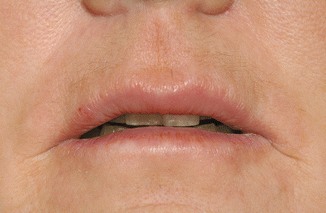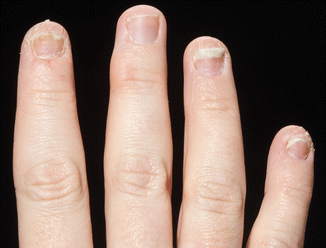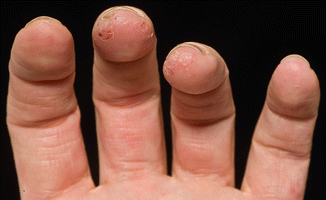Fig. 23.1
Axillary dermatitis from the fragrance present in a deodorant
23.4.4 Make-Ups Such as Foundations, Eye Shadows and Lipsticks
Leave on skin care products are a common source of cosmetic allergy, and such products have already been discussed. However, it is worth noting that there are a few allergens specific to eye make-up and lip care products.
Eye make-ups: Mascara, eyeliner, eye shadow and eyebrow pencils are the most commonly used eye make-ups. Eye make-ups are usually unfragranced. Most associated allergies are due to preservatives. Parabens are often used as the preservatives for eye shadows. However, whilst parabens frequently induce an allergic response when used on inflamed skin, this does not appear to be the case when used on intact skin, even when the skin is as thin as it is on the eyelid. This is referred to as the ‘paraben paradox’. Specific allergens to consider in cases of eyelid dermatitis include metals such as cobalt, chromate and nickel which are used to give colour to the make-ups. They are rarely reported to cause contact allergy in this context. Besides the use of eye make-up, nail varnish allergy should also be excluded in patients with periocular disease as tosyl amide formaldehyde resin in nail polish is a classic cause of eyelid dermatitis due to indirect contact. Acrylates in artificial nails can also cause eyelid dermatitis. Rubber in make-up sponges and eyelash curlers may affect the eyelids. In addition to cosmetics, allergens in contact lens solutions or eye medicaments may also cause eyelid dermatitis. Despite the wide array of reported allergens, most cases of eyelid dermatitis are irritant in nature.
Lips: Specific allergens to consider include dyes in lipstick, emollients (e.g. lanolin), UV filters, preservatives and antioxidants (e.g. propyl gallate), excipients (e.g. propylene glycol) and fragrance. Although allergic reactions to lipstick are uncommon, it should be borne in mind even when the eruption has spread beyond the lips as the sensitising chemical may well be present in products other than the lipstick. Furthermore, perioral dermatitis may be the presentation of an allergy to toothpaste or a dietary ingredient. Figure 23.2 shows cheilitis caused by contact allergy to constituents of a lip balm.


Fig. 23.2
Cheilitis caused by contact allergy to constituents of a lip balm
23.4.5 Hair Care Products Including Colourants and Styling Agents Such as Gels, Sprays and Pressing Oils
There are a wide number of different hair products which are known to be able to provoke allergic reactions. In addition to shampoos, as discussed earlier in this chapter, hair care products which can cause allergy include permanent wave solutions, straighteners and hair colouring preparations.
23.4.6 Nail Care Products Including Nail Varnishes, Paint Removers and Acrylate Nails
Historically, a constituent of nail varnish (tosylamide formaldehyde resin) was the main contact allergen; however, with the use of acrylate nails, increasing this picture has changed. Trimetallic anhydride and acrylate copolymer have also been reported. Allergic contact dermatitis to acrylates can result in paronychia and nail dystrophy as seen in Fig. 23.3.


Fig. 23.3
Paronychia and nail dystrophy caused by allergy to acrylates in nail varnish
23.5 Ingredients That May Cause Allergy
Cosmetic ingredients can be classified into several categories: fragrances, preservatives (including antimicrobials and antioxidants), ultraviolet light absorbers, excipients (vehicles), emollients, surfactants (including detergents and emulsifiers), hair styling products and dyes, nail products and acrylates.
Preservatives and fragrances are the most frequently detected classes of allergens in those with an allergy to a cosmetic product. Other important allergens include the hair colour p-phenylenediamine, the nail lacquer resin tosylamide formaldehyde resin, UV filters and lanolin. A list of potential allergens to consider testing (other than fragrances, preservatives and dyes) can be found in Table 23.1.
Table 23.1
Allergens to consider testing in patients with suspected cosmetic product allergy (excluding those allergens in the baseline series)
Group | Allergen | Test conc. and vehicle |
|---|---|---|
Preservatives [3] | 2-Bromo-2-nitropropane-1,3-diol | 0.5 % pet |
Diazolidinyl urea | 2 % pet | |
Imidazolidinyl urea | 2 % pet | |
DMDM hydantoin | 2 % aq | |
Chlorocresol | 1 % pet | |
Sodium metabisulphite | 1 % pet | |
Iodopropynyl butylcarbamate | 0.2 % pet | |
Phenoxyethanol | 1 % pet | |
Excipients | Propylene glycol | 20 % aq |
Triethanolamine | 2 % pet | |
Benzyl alcohol | 1 % pet | |
Emollients | Amerchol L 101 | 50 % pet |
Propolis | 10 % pet | |
Lanolin | As is | |
Emulsifiers and surfactants | Cocamidopropyl betaine | 1 % aq |
Cocamide DEA | 0.5 % pet | |
NB beware of irritancy and interpret with caution | ||
Dimethylaminopropylamine | 1 % pet | |
Sorbitan sesquiolate | 20 % pet | |
Oleamidopropyl dimethylamine | 0.1 % aq | |
Decyl glucoside | 10 %aq | |
Lauryl glucoside | 10 %aq | |
Cetyl alcohol, stearyl alcohol | 20 % pet | |
UV light absorbers (see Table 23.2) | ||
Hair products | Glycerol monothioglycolate | 1 % pet |
Ammonium persulphate | 2.5 % pet | |
Ammonium thioglycolate | 1 % pet | |
o-Nitro-p-phenylenediamine | 1 % pet | |
p-Toluenediamine sulphate | 1 % pet | |
3-Aminophenol | 1 % pet | |
4-Aminophenol | 1 % pet | |
Nail products (acrylates see Table 23.3) | Tosylamide formaldehyde resin | 10 % pet |
Shellac | 20 % EtOH |
23.5.1 Fragrance
Fragrances are covered in detail in Chap. 12 .
Fragrance is a leading cause of allergic skin reactions to cosmetics. Contact dermatitis to fragrance usually causes dermatitis to the hands, face and axillae. Patients appear to become sensitised to fragrance from deodorant sprays and perfumes but then go on to develop reactions to the whole host of products which contain fragrance as a constituent.
23.5.2 Preservatives
Preservatives are covered in Chap. 13.
Preservatives are the second most common cosmetic contact allergens and can be divided into various groups.
23.5.2.1 Antimicrobials
These are added to a wide range of cosmetic products to inhibit the growth of bacteria, particularly Staphylococcus aureus and pseudomonas which can flourish in an aqueous environment. This category includes formaldehyde, formaldehyde releasers and non-formaldehyde-releasing preservatives. Wet wipes frequently contain preservatives, and this was found to be the cause of the fingertip dermatitis illustrated in Fig. 23.4.


Fig. 23.4
Fingertip dermatitis due to contact allergy to preservative in a wet wipe
23.5.2.2 Antioxidants
Antioxidants are added to cosmetics to prevent the deterioration of unsaturated fatty acids and are occasionally a cause of cosmetic allergy. Antioxidants include the following:
Butylated hydroxyanisole (BHA).
Butylated hydroxytoluene (BHT).
Tocopherol (vitamin E) and its esters.
t-Butylhydroquinone.
Gallates (dodecyl, octyl, propyl): These may be found in antibiotic creams, lipsticks, moisturisers, topical steroids and eye cosmetics. Propyl gallate is particularly associated with lipsticks.
23.5.3 UV Sunscreen Allergens
Sunscreen allergens can be divided into the ‘older’ and the ‘newer’ generation of organic UV absorbers. Other topical preparations which cause a photoallergic contact dermatitis include topical NSAIDS and antihistamines. The UV absorbers can be divided into various classes: Para-aminobenzoic acid (PABA) and its esters, cinnamates, salicylates, thranilates, benzophenones and dibenzoylmethanes. Octocrylene (a cinnamate) is now the most common UV allergen, followed by benzophenone-3 and thirdly butyl methoxydibenzoylmethane. PABA and isopropyl dibenzoylmethane historically were frequently detected allergens, but numbers have fallen since these chemicals are no longer used in Europe. However, the most frequent adverse reaction to sunscreen is irritation, which occurs in 15 % of users. Currently recommended allergens for testing can be found in Table 23.2.
Agents recommended for the European photopatch test baseline series | ||
|---|---|---|
Type of agent | Allergen | Test conc. and vehicle |
‘Older’ organic UV absorbers | Butyl methoxydibenzoylmethane | 10 % pet |
Benzophenone-3
Stay updated, free articles. Join our Telegram channel
Full access? Get Clinical Tree
 Get Clinical Tree app for offline access
Get Clinical Tree app for offline access

| ||




